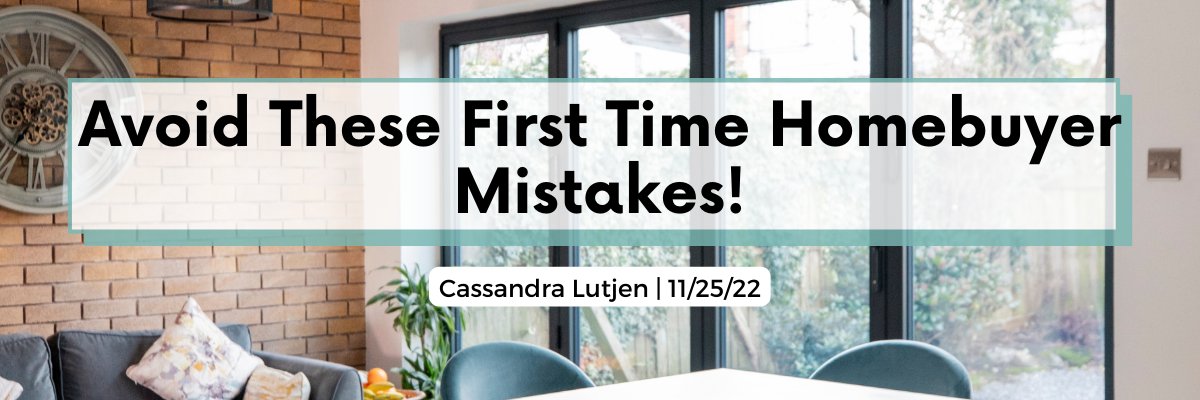6 First Time Homebuyer Mistakes To Avoid

Are you looking to buy your first home? A lot of first-time home buyers make common mistakes. It‘s no secret that buying a home can be a daunting task. Thankfully, it‘s possible to be a prepared, informed buyer, so you can find the home you want and make a successful purchase.
Steer clear of these common pitfalls as you prepare for your home-buying journey.
Don’t find out too late that you can’t afford your dream home. Before you start shopping, do a little budgeting.
Whether you’re price-limiting or ceiling-gauging, you should definitely take a look at your budget before you start looking for a house. It’s easy to get excited about the big house up the hill, but if it’s out of your price range don’t fall in love!
Generally, your monthly mortgage payments shouldn’t be much more than 28 percent of your monthly gross income. If you have a lot of other debt, that percentage should be even lower. Make estimates based on your current income, not on what you anticipate making a few years down the line.
BONUS TIP: Before you meet with a lender, decide the monthly payment you’re comfortable with. And tell your lender the amount you want to spend and ask what price range that puts you in. Because who cares what you can get approved for if you’re not comfortable spending that amount?
As a first-time homebuyer, it’s your responsibility to prove the income you’ll use for payments.
You may need to take some extra time to gather the documentation you’ll need such as our tax returns, pay stubs, and financial account statements. Also, check your credit report. How does your credit look? Your credit standing and debt-to-income ratio will affect what interest rates you‘ll get when you apply for a loan.
Your credit history tells a lot about you. Knowing what’s in there can help you plan for the future and avoid surprises.
What’s the difference between pre-qualification and pre-approval? Basically, one will kick start the mortgage process, while the other gives you a binding commitment. Know how to get a mortgage before jumping in!
Pre-qualification
An estimate of the amount of mortgage you can afford. You provide basic financial information to a lender such as how much money you earn, how many debts you have, and your credit score. Then the lender provides estimates on how much you can borrow.
Pre-approval
This goes a step further; this one is more official. Homebuyers must contact a lender for pre-approval or fill out the appropriate forms for a lender to electronically provide pre-approval. You will use these pre-approval letters for the actual homebuying processes.
Although these terms are similar by name and in function, the pre-qualification is mostly for buyers’ initial affordability planning, while pre-approval is the legitimate step that can help with negotiating and expediting the purchase process.
This may not be the most exciting thing in the world, but a home inspection will let you know exactly what kind of shape your future home is in before you buy.
The home inspection is an added expense that not every first-time homebuyer might know about. If there are problems with the house, your contractor can tell you what they’re going to cost and tell you if it’s worth buying the house or not. You don’t want to find out after you’ve bought it.
Plus, a home is probably the biggest purchase of your life and you want to know what it really needs. Home inspections are a great way to avoid nasty surprises later on.
If the home needs big repairs you can’t see, an inspection helps you negotiate with the current homeowner to have the issues fixed or adjust the price accordingly.
When you hear a friend say that the only thing you need to buy a house is a downpayment, unfriend them! Just kidding!
The size of your down payment might be the biggest factor in how much house you can buy. But other factors matter too, such as closing costs and whether you’ll need mortgage insurance. Typically, closing costs total 3 to 5 percent of your home’s purchase price, so add this cost to your budget.
Get a clear picture of how much it will actually cost to get into your dream home.
A mortgage payment is just the beginning. If you‘re a first-time homebuyer, it can be a big surprise to learn that your monthly mortgage payment doesn’t cover all the costs of owning a home.
On top of your monthly mortgage payment, other costs you need to allot in your budget include monthly utility bills, property taxes, homeowners insurance, regular maintenance, and homeowners’ association fees.
Remember, when you’re making you’re figuring out how much you can afford to pay each month for a house, don’t forget to factor in these expenses as well.
The Bottomline:
Don’t panic! Becoming a first-time homebuyer is an exciting experience, but it might feel like a bit of a beast to tackle all on your own. While getting your finances in order and preparing for the journey can seem daunting, there are plenty of ways you can take it one step at a time.
The best time to buy a house is when you are ready.
My goal is to help every homebuyer understand what they’re getting into. That’s why I created a HOMEBUYING GUIDE you can download for FREE! It’s a quick, easy guide to make sure you have all your bases covered when buying a house.
Your home will likely be the biggest purchase of your life. Wouldn’t you like someone that cares to guide you through the process and make sure you have the best options available? Connect with me and let’s get you started finding that dream home!
Follow me for more real estate tips!






